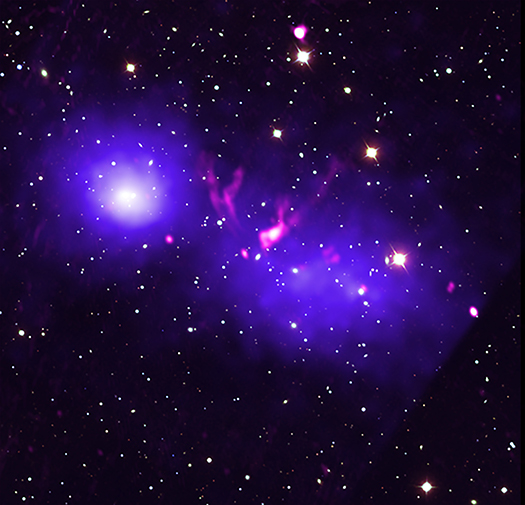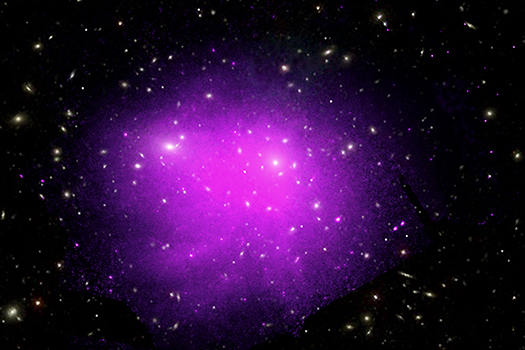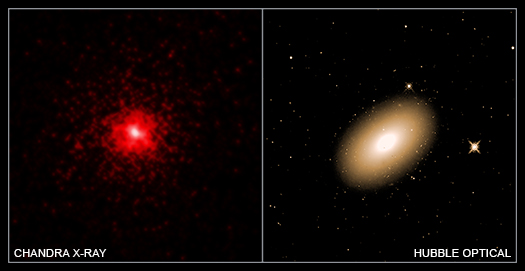Galaxy Clusters Caught in a First Kiss

Cluster Merger
Credit: X-ray: NASA/CXC/RIKEN/L. Gu et al; Radio: NCRA/TIFR/GMRT; Optical: SDSS
For the first time, astronomers have found two giant clusters of galaxies that are just about to collide, as reported in a new press release by RIKEN. This observation is important in understanding the formation of structure in the Universe, sincelarge-scale structures—such as galaxies and clusters of galaxies—are thought to grow by collisions and mergers.
The composite image shows the separate galaxy clusters 1E2215 and 1E2216, located about 1.2 billion light years from Earth, captured as they enter a critical phase of merging. Chandra’s X-ray data (blue) have been combined with a radio image from the Giant Metrewave Radio Telescope in India (red). These images were then overlaid on an optical image from the Sloan Digital Sky Survey that shows galaxies and stars in the field of view.
Does the Gas in Galaxy Clusters Flow Like Honey?

Coma Cluster
Credit: X-ray: NASA/CXC/Univ. of Chicago, I. Zhuravleva et al, Optical: SDSS
This image represents a deep dataset of the Coma galaxy cluster obtained by NASA's Chandra X-ray Observatory. Researchers have used these data to study how the hot gas in the cluster behaves, as reported in our press release. One intriguing and important aspect to study is how much viscosity, or "stickiness," the hot gas demonstrates in these cosmic giants.
Galaxy clusters are comprised of individual galaxies, hot gas, and dark matter. The hot gas in Coma glows in X-ray light observed by Chandra. Seen as the purple and pink colors in this new composite image, the hot gas contains about six times more mass than all of the combined galaxies in the cluster. The galaxies appear as white in the optical part of the composite image from the Sloan Digital Sky Survey. (The unusual shape of the X-ray emission in the lower right is caused by the edges of the Chandra detectors being visible.)
New Chandra Operations Control Center Opens

Chandra's New Operations Control Center
A new state-of-the-art facility that will operate NASA's Chandra X-ray Observatory has opened. This new Operations Control Center, or OCC, will help Chandra continue its highly efficient performance as NASA's premier X-ray observatory.
As the name suggests, the OCC controls the operation of the Chandra spacecraft while it is in orbit, as scientists and engineers design plans for efficiently and safely observing its targets.
Two years before Chandra's launch into space in 1999, NASA awarded the Smithsonian Astrophysical Observatory a contract to establish the first OCC as part of the Chandra X-ray Center, under the direction of NASA's Marshall Space Flight Center. Northrup Grumman was and continues to be a prime contractor for Chandra, employing many staff members at the OCC.
X-Rays Help Prove Some Galaxies are True Relics of the Ancient Universe

Professor David Buote
We welcome Professor David Buote as our guest blogger. Buote was one of the first Chandra Postdoctoral Fellows and is now a Professor at the University of California at Irvine. He has studied X-rays from massive elliptical galaxies and galaxy clusters since the time he was a graduate student. His new work with Aaron Barth on the dark matter in a relic elliptical galaxy is the subject of our latest press release.
This year marks the 20th anniversary of the Chandra X-ray Observatory and a chance to celebrate its many and diverse accomplishments. A critical aspect of Chandra's impact on astrophysics is its synergies with observations of phenomena throughout the electromagnetic (EM) spectrum and through other channels like gravity waves and neutrinos. Our study highlights how studies of the X-ray emission of a rare type of galaxy complement and augment what has been learned from observations of the stellar light at longer wavelengths.
Galaxies are broadly divided into two types — disks and spheroids — with substantial overlap in their properties. The spheroids — or elliptical galaxies — are approximately round but range in shape as observed on the sky from nearly circular to elongated somewhat like an American football viewed from the side. Most of what we know about the stars in galaxies comes from observations of visible light photons with lots of help from observations in the nearby ultraviolet and infrared (IR) parts of the EM spectrum.
Hunting for Stellar CMEs: The Chandra Success
We are pleased to welcome Costanza Argiroffi as a guest author. Costanza led the study reporting the first secure detection of a coronal mass ejection from a star other than the Sun. She is an astrophysicist from the University of Palermo, Italy, where she is from. Her main research field is the study of low-mass stars. She obtained her PhD from the University of Palermo in 2006, and during her studies spent a few months at the Smithsonian Astrophysical Observatory in Cambridge, MA. Then she worked as a postdoc and, since 2008, as a researcher at the University of Palermo.
Coronal Mass Ejections (CMEs) are large-scale expulsions of material previously confined in the atmosphere of a star. CMEs are among the most powerful magnetic phenomena occurring in the atmosphere of the Sun, reaching velocities of about 2 million miles per hour, masses of about 200,000 billion pounds, and kinetic energies equivalent to about 125 million Krakatoa eruptions.
Using data from NASA’s Chandra X-ray Observatory, we have made the first unambiguous detection of a CME by a star other than the Sun.
Heart of Lonesome Galaxy is Brimming with Dark Matter
Data from NASA's Chandra X-ray Observatory (left) have helped astronomers reveal that a galaxy has more dark matter packed into its core than expected after being isolated for billions of years, as reported in our press release. The image on the right shows the galaxy called Markarian 1216 (abbreviated as Mrk 1216) in visible light from NASA's Hubble Space Telescope over the same field of view.
Mrk 1216 belongs to a family of elliptically shaped galaxies that are more densely packed with stars in their centers than most other galaxies. Astronomers think they have descended from red, compact galaxies called "red nuggets" that formed about a billion years after the Big Bang, but then stalled in their growth about 10 billion years ago.
Chandra Finds Stellar Duos Banished from Galaxies
This image from NASA's Chandra X-ray Observatory shows the region around NGC 1399 and NGC 1404, two of the largest galaxies in the Fornax galaxy cluster. Located at a distance of about 60 million light years, Fornax is one of the closest galaxy clusters to Earth. This relative proximity allows astronomers to study the Fornax cluster in greater detail than most other galaxy clusters.
"Journey Through an Exploded Star" Opens
A new way to interact and explore Cassiopeia A, the remains of an exploded star, has launched. The press release below outlines this novel initiative between the Smithsonian Center for Learning and Digital Access and the Chandra X-ray Center. Led by Chandra’s Kimberly Arcand, this project allows you to watch, interact, or learn about this supernova remnant while delving into astrophysics, computer science, and more.
This online interactive version of Cas A (as it’s referred to) is one latest milestone with Chandra. Cas A was the “First Light” image that Chandra observed just weeks after being launched into space in 1999. In the nearly twenty years since, Chandra has repeatedly observed Cas A, revealing new secrets about this object from the neutron star at its center to the elements of life it has expelled.
A decade ago, a team of scientists and image processors came together and created the first-ever three-dimensional model of Cas A. Now, this 3D model enters a new phase with the launching of "Journey Through an Exploded Star"” We hope you will explore with us.
A Magnetar-powered X-ray Transient as the Aftermath of a Binary Neutron-star Merger

Yongquan Xue
We are pleased to welcome Yongquan Xue, a professor at the Department of Astronomy, University of Science and Technology of China (USTC), as a guest blogger. He is an astrophysicist whose main research field is X-ray high-energy astrophysics, and has been significantly involved in the Chandra Deep Fields. Yongquan led the Nature paper that is the subject of our latest press release on the discovery of a magnetar-powered X-ray transient. Before joining USTC in 2012, he worked at Penn State University as a postdoc, after obtaining his astrophysics B.S. and M.S. degrees at Peking University, and Ph.D. degree at Purdue University, respectively.
A neutron star is the compact object formed after a supernova explosion occurring in the late evolutionary stage of a massive star, and it is one of the most mysterious objects in the universe. It is composed of almost all neutrons, and has some extreme physical properties such as ultra-high density and a super-strong magnetic field. It is an excellent natural laboratory for testing basic physical laws. However, up to now, our understanding about the basic properties of neutron stars (e.g., the equation of state, which describes the relation among pressure, density, etc.) is still relatively vague.
A New Signal for a Neutron Star Collision Discovered

CDF-S XT2
Credit: X-ray: NASA/CXC/Uni. of Science and Technology of China/Y. Xue et al; Optical: NASA/STScI
These images show the location of an event, discovered by NASA's Chandra X-ray Observatory, that likely signals the merger of two neutron stars. A bright burst of X-rays in this source, dubbed XT2, could give astronomers fresh insight into how neutron stars — dense stellar objects packed mainly with neutrons — are built.




